- 9 Best Diversity Tools for Job Descriptions in 2025 - January 6, 2025
- 7 Eye-Catching Recruiting Stats from Silkroad’s 2017 “Sourcing Report” - July 11, 2017
- How to Write Job Descriptions that Attract the Right “Persona” - May 1, 2017
Things are changing fast in the job market. And having a diverse team is super important nowadays. Today, we’re not just talking about hiring. We’re also talking about creating a workplace where everyone feels included and valued. And diversity tools can help with that.
So, we’re on a mission to discover some awesome tools that can make your hiring process better and more inclusive. Imagine finding the perfect fit for your team while embracing different talents as well as perspectives. That’s what we’re all about!
Get ready to explore the coolest diversity tools that can help your business grow.
Excited? We sure are!
Here are 9 of the best diversity tools to write more inclusive job descriptions to attract a more diverse team.
1. Text Analyzer by Ongig
Ongig’s Text Analyzer software takes out bias and makes ad copy better. When you’re writing job descriptions, best practices to make them diverse include replacing gender-coded words and other types of bias (e.g., race, age, disability, etc.)
So, we created Text Analyzer after rewriting thousands of job descriptions for some of the largest brands in the world. Ongig’s software has improved branding and engagement (video, pictures, maps, chat, etc.) for job descriptions since 2011.
Text Analyzer has a super-easy interface that acts as a bias decoder. Some have even called it:
“a diversity job ad proofing tool.”
How Text Analyzer works
First, you get a dashboard of Total Score and Gender Bias Scores. This is filterable by team, location, recruiter, and hiring manager. So, you even see how you compare to your top competitors. Then, you dive into each piece of job description language with easy recommendations on how to easily improve your scores.
Text Analyzer’s early focus in 2017 was being a gender bias tool. So, the main focus was to flag gender coding in job descriptions:
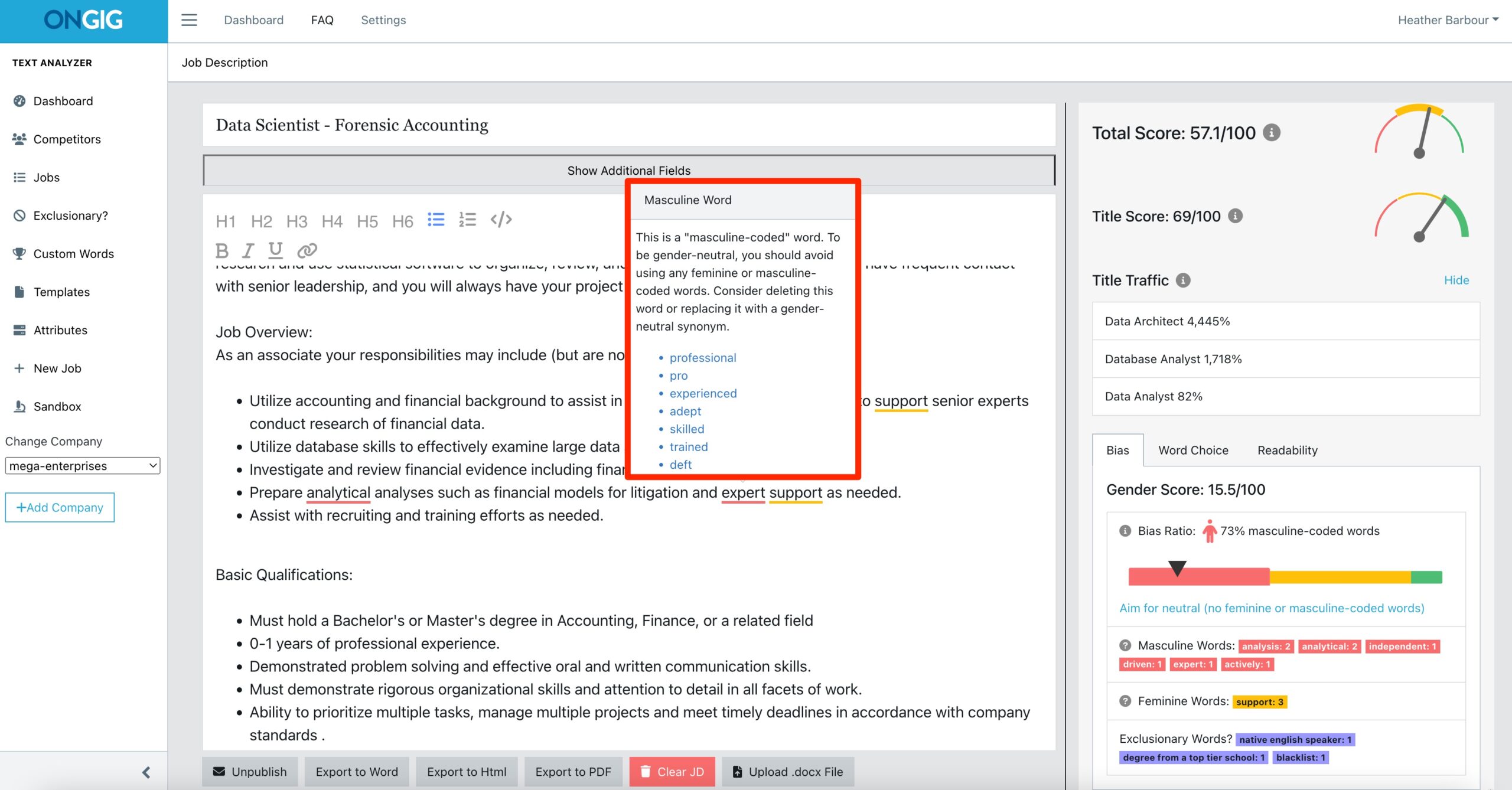
But we quickly found that employers wanted to write more inclusive job descriptions. And that goes far beyond gender and “manly terms”. To have diverse friendly job descriptions, you also need to get rid of bias re:
- race
- country of birth
- age
- disability
- sexual preference
- neurodiversity
- former felons
- veterans
What is gender coding?
“Gender Coding are the signals that individuals manifest externally and that indicate their sexuality or relative masculinity or femininity.”
source: Springer Link
Fast forward to today: Here’s a more recent Text Analyzer screenshot showing an example of the phrase “Brown Bag sessions”. The image also show that might offend people of color:
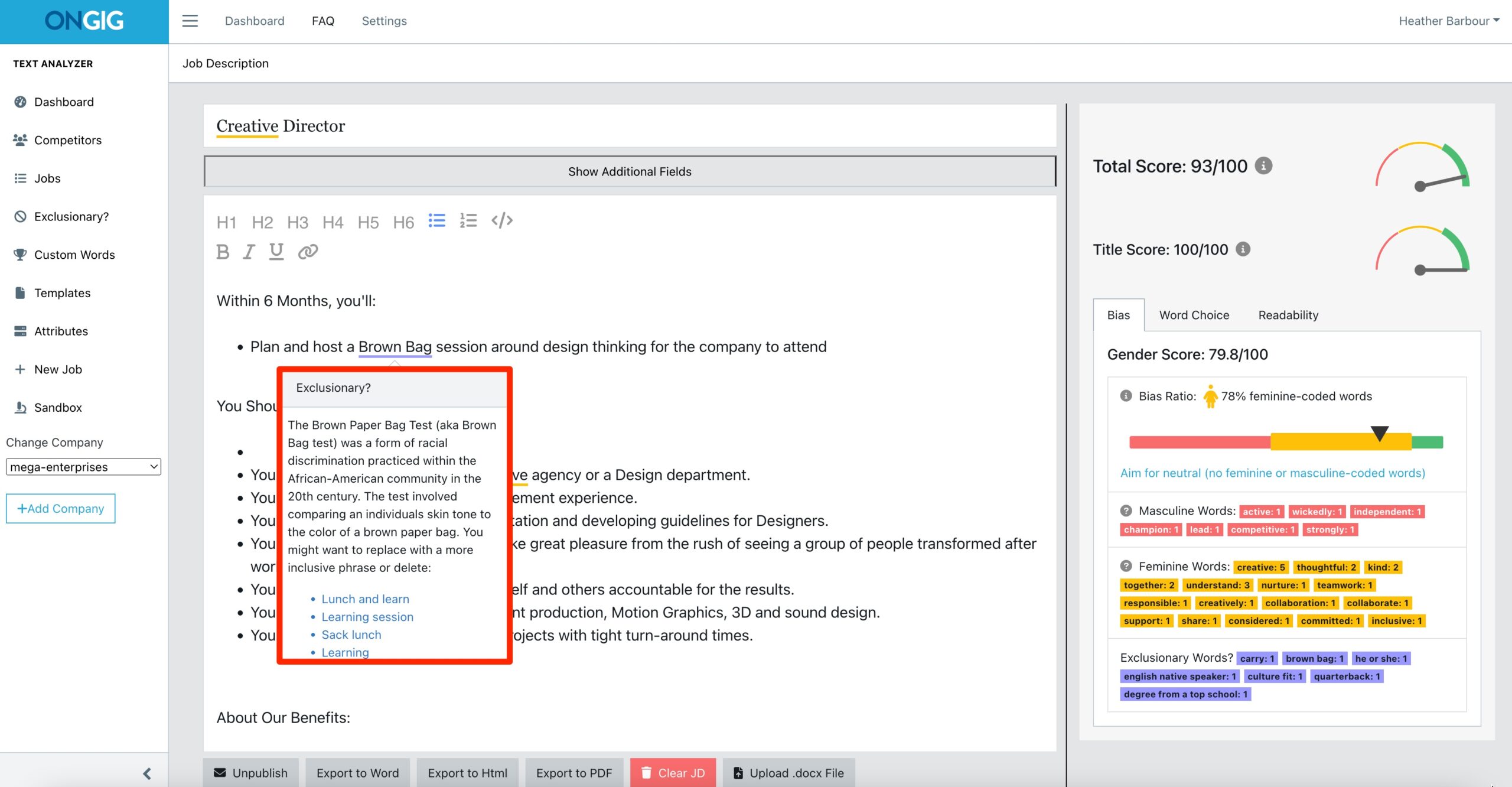
At Ongig, we want to ensure that we are setting you up for success. So, we go out into the field to speak with employers we speak with who’ve compared Ongig vs. Textio. And they tell us that Ongig goes much deeper as a job description bias tool. Whereas Textio focuses more of its features on augmented writing. There are hundreds of terms on the software’s biased words list with inclusive replacements. So, we don’t just tell you what’s wrong and leave it at that. We also give you what you need to make it better right away.
Beyond bias, Text Analyzer makes your content more readable. This includes proper length of sentences, paragraphs, and the entire job description. Check out below to see how the tool flags an unnecessarily complex phrase. You will also notice the punchier suggestion provided to swap right in:
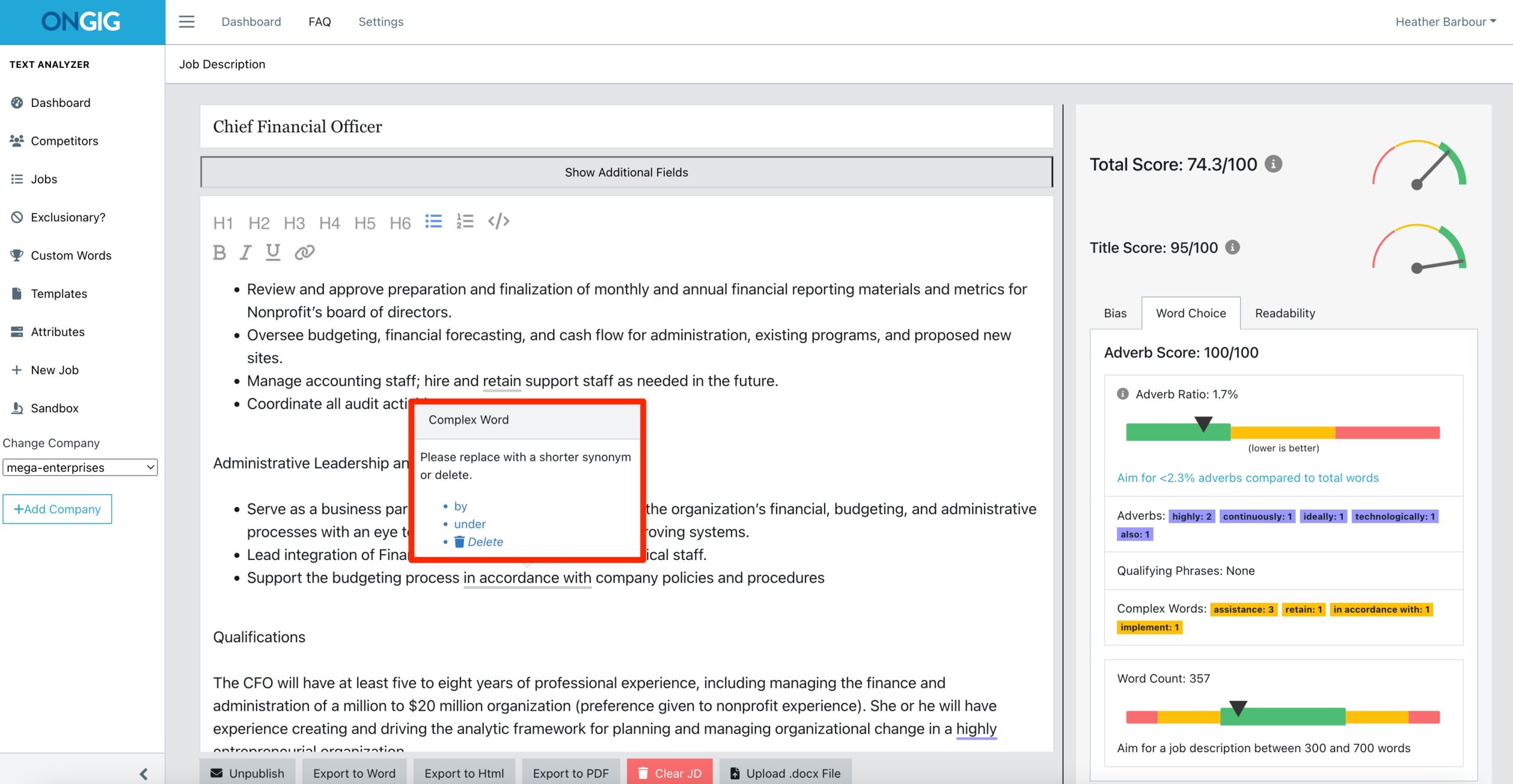
Text Analyzer also scans your job descriptions using AI to find missing sections candidates care about. These include, for example, salary, benefits, mission statement, diversity statement, and more. So, here’s a snapshot of the “Section Finder” in action:
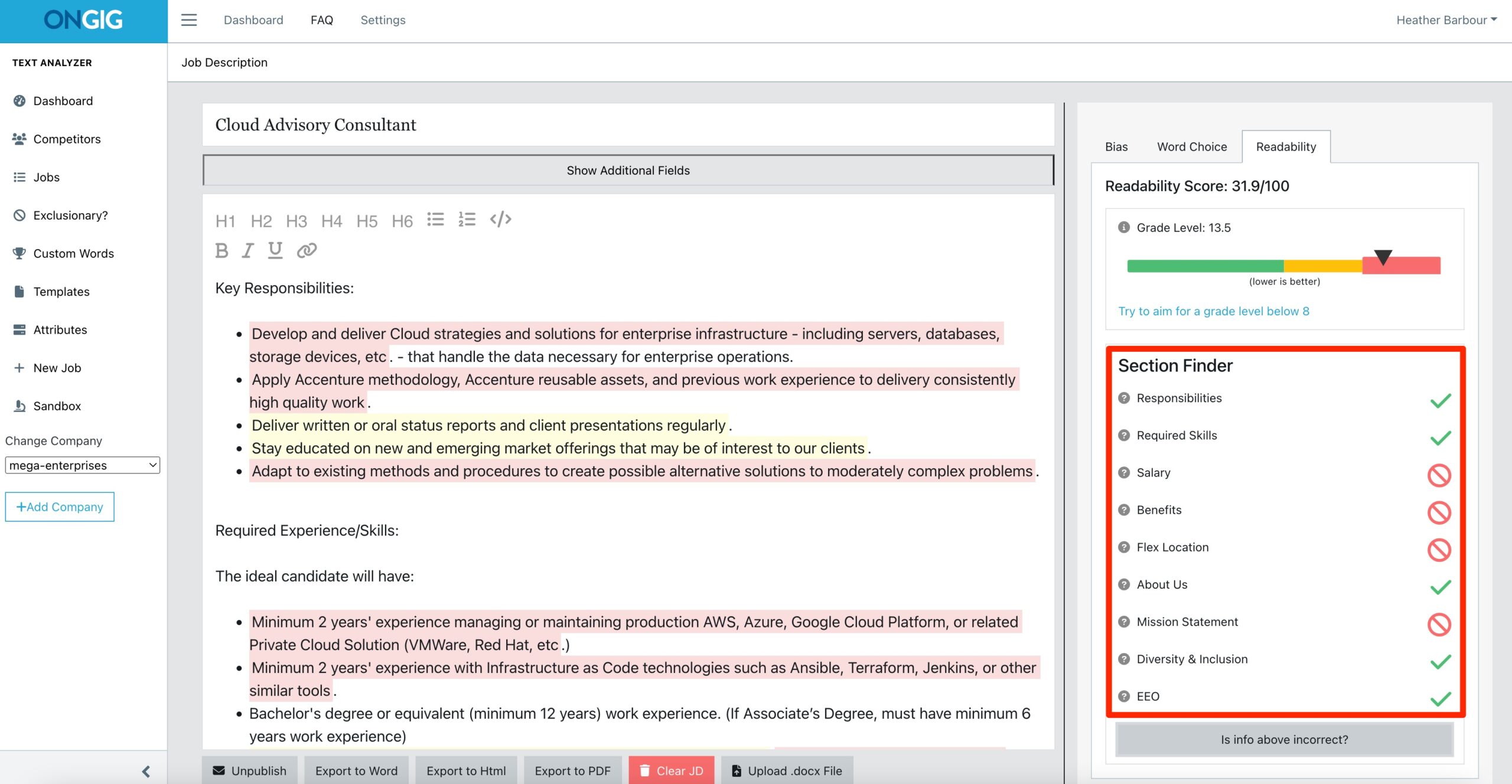
2. Textio
Another such tool is Textio (aka “text io”). It’s an online writing platform made by job posting outcomes from recent job openings. These outcomes allow Textio to analyze your job description language and provide a score of how it stacks up in terms of diversity, neutrality, and overall success. Feedback is given in the way of color-coded words with suggestions for improvement.
Textio also uses gender writing analysis to flag and offer replacements for “manly terms”. You can see the scale in the bottom right below showing “masculine tone”:
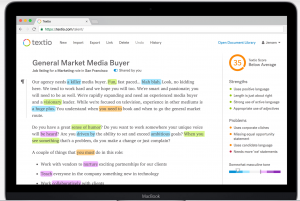
Note: Here’s a list of 7 Textio Competitors.
3. Gender Decoder
Gender Decoder is a simple (and free) job description tool for gender writing analysis. It was created by Kat Matfield based on a study that looked at the psychology of how different words attracted males and females to certain jobs (aka gender coding in JDs). The tool compares your text to feminine and masculine word listings created from the study using a list of gender words.
For small businesses, Gender Decoder is a good free alternative to Textio and Ongig if you care just about flagging gender-biased words. Here’s an example of its gender checker results:
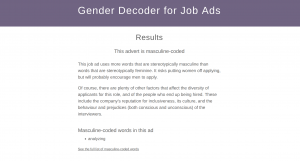
4. Clovers
Another alternative is Clovers (formerly Talvista). Clovers is an online platform created to guide hiring
teams through a more efficient and more inclusive hiring process. Its interface follows a step-by-step progression. And it’s also very user-friendly.
In particular, the integrated job description builder lets you type new or paste existing job description content into predetermined sections. The tool also reviews text for word choice, and positive or negative language. In addition, it has a gender decoder feature, giving alternative options to the user. We haven’t heard anything about how this product compares to Textio or Ongig. But, you notice below the tool uses text gender analysis by flagging feminine words in green and masculine words in red (similar to the other tools).
Here’s a screenshot of Clovers’ job description optimizer in action:
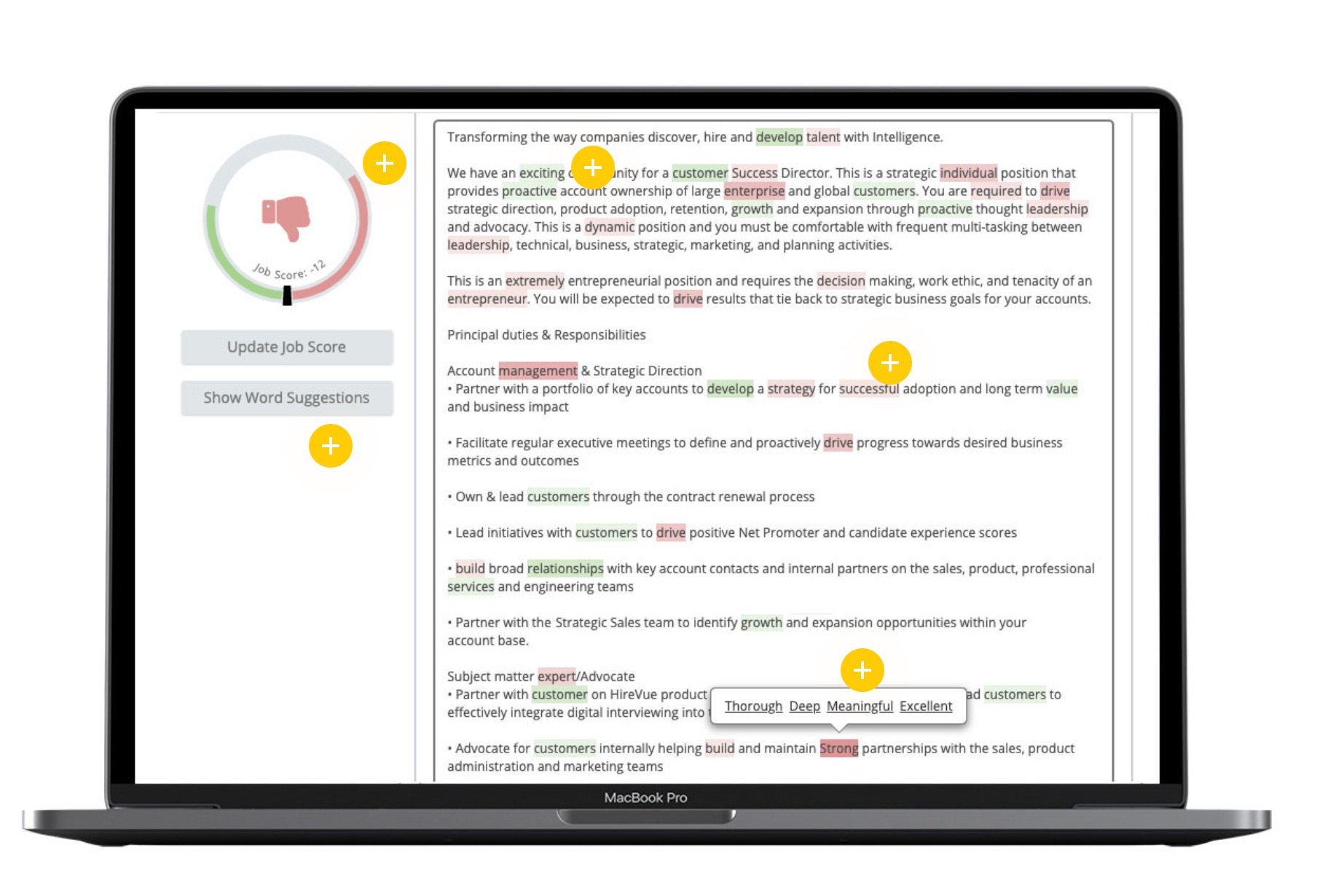
5. The Polite Type
A top goal for heads of recruiting is diversity and inclusion. So, job description software is an easy place to start. The PolIte Type is not exactly made for JDs, but it’s good at “disarming bullies one word at a time.” The Polite Type is a free open source tool that auto-rewrites hurtful words (e.g., “kike” or “negro”) and replaces them with more inclusive words (e.g., “jewish person” or “Black person”). This software is not a gender analyzer, but more focuses on other types of bias and words used in bullying.
Here’s another example of the tool in action:
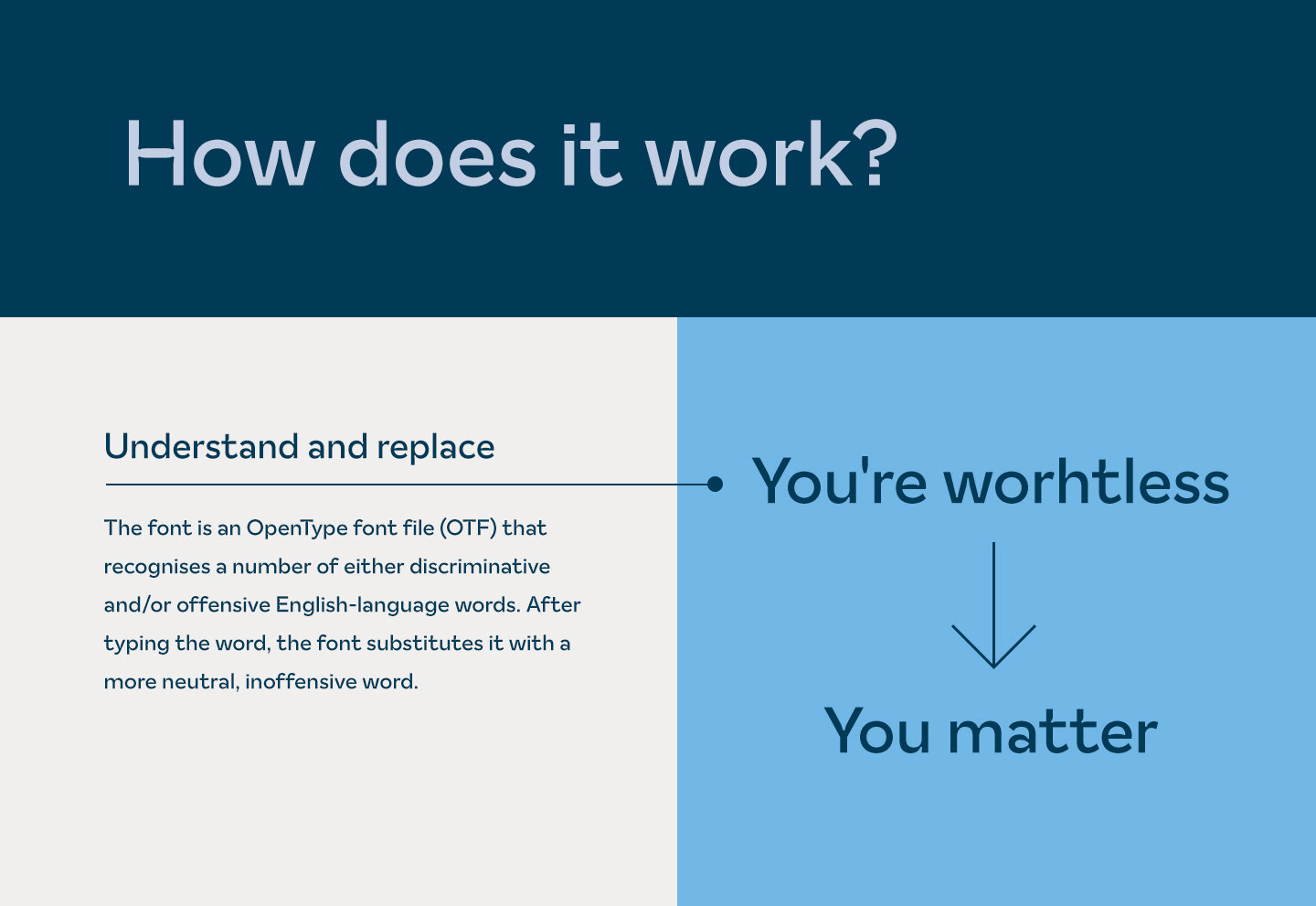
The terms for this tool are co-created with high-school-aged teenagers and kids from diverse backgrounds in Finland. And this is also done in partnership with The Children and Youth Foundation.
6. Allie
Allie is your dependable chatbot companion in the workplace. This is a versatile tool for fostering inclusivity and diversity within your organization. Here’s a breakdown of Allie’s capabilities:
To start, Allie specializes in maintaining seamless communication on Slack. She excels at disseminating D&I surveys, affording every employee the opportunity to express their perspectives on inclusion and company culture. These surveys delve into crucial areas such as the consideration of diverse viewpoints in recent organizational decisions.
But Allie’s utility extends beyond survey administration. She also serves as a conduit to the latest developments in diversity-related news. Allie adeptly delivers articles directly to your company’s D&I Slack channel. Thus, ensuring that you remain abreast of current events and trends in the diversity landscape.
Moreover, Allie is committed to driving substantive change. Through her feedback feature, employees can proactively propose enhancements to diversity and inclusion efforts. Whether it involves combating stereotypes or ensuring the inclusivity of all individuals, Allie stands ready to facilitate tangible progress.
Additionally, Allie offers invaluable diversity training sessions, equipping team members with the knowledge and skills necessary to navigate diverse workplace environments effectively.
Whether through survey administration, news dissemination, or training provisions, Allie empowers organizations to effect positive change and foster an environment where every voice is heard and valued.
7. Blendoor
Blendoor is a diversity analytics and hiring software company that’s all about making hiring fair and inclusive. Here’s what you need to know about Blendoor:
First off, they’re big on unbiased hiring. Blendoor promotes fair hiring practices by using blind recruitment and sourcing candidates from diverse backgrounds. So, this helps tackle unconscious bias in the hiring process.
But here’s where it gets interesting: Blendoor’s software isn’t just about making things fair – it’s also super smart. They use data from the government and the marketplace to give organizations a score. This score shows how well they’re doing compared to other companies in terms of diversity, equity, and inclusion.
And it doesn’t stop there. Blendoor helps organizations improve their hiring processes by providing ratings on their diversity efforts, giving insights into where they can do better. They also offer tools for tracking diversity over time, so organizations can see how they’re progressing.
Plus, Blendoor’s assessment tool helps organizations identify areas where they can make their hiring processes more inclusive. It’s like having a personal coach for your hiring team, guiding them towards making better, more inclusive decisions.
8. DBSquared
DBSquared helps companies build fairer and more equitable workplaces. Let’s dive into what they’re all about:
First up, DBSquared is equipped with tools to help companies level the playing field when it comes to hiring and compensation. Take their job description software, DBDescriptions, for example. It helps companies write job postings that are fair and unbiased. Plus, it ensures these postings are compliant with important regulations like the ADA and FLSA.
But that’s not all. DBSquared also offers compensation management software called DBCompensation. This tool helps HR staff pinpoint any pay disparities within their organization. So, by analyzing factors like experience, race, and gender, DBCompensation creates charts that highlight any discrepancies. For instance, it might reveal that a Latino supervisor is earning significantly less than a white supervisor with the same level of experience.
Special Features:
- They’re all about enhancing HR efficiency through their software products and services.
- With a focus on web design and bespoke software development, they cater to the needs of small and medium-sized businesses.
- DB Squared Holdings has a big vision – they aim to create a future where prosperity and inclusivity go hand in hand through innovative partnerships.
- And hey, they’re not just about HR software. DB Squared Logistics specializes in transport logistics solutions.
One of their standout offerings is CompBldr, a software that simplifies job description creation, comparative analysis, and fair pay structures. With CompBldr, companies can ensure they’re offering fair compensation to all employees, promoting inclusivity and fairness in the workplace.
DBSquared serves a wide range of industries, championing efficiency and fairness in HR operations wherever they go. With their tools and expertise, they’re helping companies build more inclusive cultures and create workplaces where everyone has a fair shot.
9. Diversio
Let’s take a closer look at Diversio and how it’s shaking things up in the world of diversity, equity, and inclusion (DEI):
First off, Diversio’s got this cool tool called the Bias Corrector. It’s like having a personal assistant for your communication platform, such as Slack. This nifty tool flags any cultural insensitivity or unconscious bias in your company’s communications. Thus, helping you stay on top of things and create a more inclusive environment.
Then there’s the Social Media Barometer. So, this clever tool keeps an eye on what people are saying about your company on social media. If there are any complaints about your D&I record, you’ll know about it. This way you can take action and address any concerns.
But that’s not all – Diversio’s Recommendation Engine is where the magic really happens. Using algorithms, it matches up your company’s challenges with the best course of action to tackle them head-on. So, it’s like having a personal advisor, guiding you towards making the right decisions for your organization’s diversity and inclusion efforts.
Special Features:
- Powered by AI technology and a Recommendation Engine, Diversio’s DEI platform helps quantify experiences and uncover biases. It’s like having a super-smart assistant, giving you insights into where you can make improvements.
- Their analytics tool, recognized by ComputerWorld, helps organizations identify bias blind spots and figure out where they need to focus their efforts.
- With benchmarking features built into their cloud-based tool, Diversio makes it easy for HR and DEI teams to compare their efforts to industry standards and identify areas for growth.
- And don’t forget about measurement and tracking – crucial for fostering inclusivity and diversity. The Diversio Platform helps organizations measure, track, and improve every employee’s experience, ensuring everyone feels valued and included.
In a nutshell, Diversio provides a comprehensive suite of DEI tools that are essential for driving meaningful change in organizational diversity and inclusion efforts.
I hope the above diversity tools for writing more inclusive job descriptions are helpful to you! For more tips on writing job descriptions, check out How to Write a Job Description — Best Practices & Examples.
Enhancing Work Culture with Diversity Tools
When it comes to building a thriving work culture, diversity, equity, and inclusion (DEI) play a crucial role. That’s where diversity tools come in handy, especially job description tools like Ongig Text Analyzer. Let’s dive into the benefits these tools bring to the table:
Creating Inclusive Job Postings with Diversity Tools:
With the right diversity tools, crafting job postings that attract diverse candidates becomes a breeze. These diversity tools help remove bias from job descriptions, ensuring they appeal to candidates from all backgrounds. So, by using inclusive language and highlighting the company’s commitment to diversity, you can attract a wider pool of qualified candidates.
Expanding Talent Pools with Diversity Tools:
Diversity tools open doors to a broader range of candidates, including those from underrepresented groups. This not only enriches the talent pool. But it also brings fresh perspectives and innovative ideas to the table. Therefore, by casting a wider net, companies can tap into a wealth of diverse talent and foster a more inclusive workforce.
Mitigating Unconscious Bias with Diversity Tools:
Unconscious bias can creep into the hiring process, leading to unfair treatment of candidates. However, diversity tools like Ongig Text Analyzer leverage AI to identify and eliminate bias in job descriptions. So, removing biased language and criteria, helps ensure that all candidates are evaluated based on their qualifications and skills, rather than irrelevant factors.
Improving Workplace Culture with Diversity Tools:
Companies signal their commitment to creating an inclusive work environment, by embracing diversity tools. This sends a powerful message to employees that diversity is valued and celebrated within the organization. As a result, employees feel more engaged, respected, and motivated, leading to a positive workplace culture where everyone can thrive.
Driving Positive Change with Diversity Tools:
Diversity tools not only benefit individual companies. They also contribute to broader societal change. So, by promoting diversity and inclusion in the workplace, companies play a role in addressing systemic inequalities and creating a more equitable society. Through their actions, they set an example for others to follow. Thus, driving positive change within their industries and beyond.
Measuring and Tracking Diversity Initiatives
In today’s workplace, creating an inclusive culture is essential for attracting diverse candidates and building a diverse workforce. But how do we know if our diversity efforts are making a real difference? That’s where measuring and tracking diversity initiatives come into play. Let’s take a closer look at why this is so important and how the right diversity tools can help.
Why Measure Diversity Initiatives?
Imagine you’re on a journey to make your workplace more inclusive. How do you know if you’re heading in the right direction? That’s where measurement comes in. So, by tracking things like diversity representation, employee engagement, and inclusion efforts, you can see what’s working and what needs improvement.
Using Data-Driven Insights
Nowadays, we’re lucky to have diversity tools that can crunch numbers and analyze data for us. These tools use things like artificial intelligence to help us understand our workforce better. By looking at data points like job postings, social media mentions, and performance reviews, we can spot trends and patterns that we might have missed otherwise.
Identifying Areas for Improvement
No workplace is perfect, and there’s always room for improvement. Therefore, measuring diversity initiatives, shines a light on areas where we might be falling short. Maybe we’re not attracting enough diverse candidates. Or perhaps there’s a gap in representation at certain levels of the organization. Whatever the case, data from these diversity tools can help us see where we need to focus our efforts.
Setting Benchmarks and Goals
Setting goals gives us something to aim for. When it comes to diversity initiatives, benchmarks help us track our progress over time. So, by setting realistic goals and monitoring our performance, we can stay on track and hold ourselves accountable for creating a more inclusive environment.
Creating Actionable Insights
Data is only valuable if we know what to do with it. That’s where actionable insights come in. So, using diversity tools to turn data into meaningful insights, we can make informed decisions about how to improve our diversity efforts. Whether it’s adjusting our recruitment strategies or investing in training programs, data helps us make smarter choices.
Continuous Improvement
Finally, diversity work is never done. It’s an ongoing journey that requires constant attention and effort. Continuously measuring and tracking our diversity initiatives, helps us to stay agile and adapt to changing needs. So, with the right diversity tools and a commitment to positive change, we can create a workplace where everyone feels valued and included.
The Role of Leadership in Diversity and Inclusion
In the journey towards building a more inclusive culture, the role of leadership is paramount. HR leaders and business executives play a crucial role in shaping the diversity and inclusion (DEI) efforts of an organization. Let’s explore why leadership is instrumental in driving DEI initiatives and how it impacts the workplace environment.
Setting the Tone:
Leadership sets the tone for the entire organization. So, when leaders prioritize diversity and inclusion, it sends a clear message that these values are fundamental to the company’s culture. This commitment trickles down through every level of the organization, creating an environment where everyone feels valued and respected.
Creating Inclusive Policies:
HR leaders and executives are responsible for developing and implementing inclusive policies and practices. From recruitment processes to performance evaluations, leaders must ensure that every aspect of the employee experience is designed to promote diversity and equity.
Fostering Courageous Conversations:
Effective leaders encourage open and honest conversations about diversity and inclusion. They create safe spaces for employees to share their experiences, voice concerns, and offer suggestions for improvement. Therefore, by fostering courageous conversations, leaders can address issues of bias and discrimination head-on, leading to a more inclusive environment.
Leading by Example:
Leadership is not just about words; it’s about actions. So, when leaders actively demonstrate inclusive behaviors, such as seeking out diverse perspectives, championing underrepresented groups, and holding themselves and others accountable for their actions, it inspires employees to do the same.
Driving Accountability:
HR leaders and executives play a critical role in holding themselves and others accountable for diversity and inclusion goals. They set measurable objectives, track progress, and implement strategies to address any gaps or challenges. Therefore, making diversity and inclusion a priority at every level of the organization, helps leaders drive meaningful change.
Why I wrote this?
Ongig is on a mission to help you create the most attractive, engaging, and effective job descriptions in your industry (if not the world!). Ongig’s Text Analyzer software transforms job descriptions to free you up your recruiters and hiring managers. And if you don’t want to rewrite your job descriptions yourself, one alternative for you is to hand the task over to Ongig’s pro copywriting. And we will get them done for you. Click the demo request button above if you’d like to learn more about Text Analyzer.
